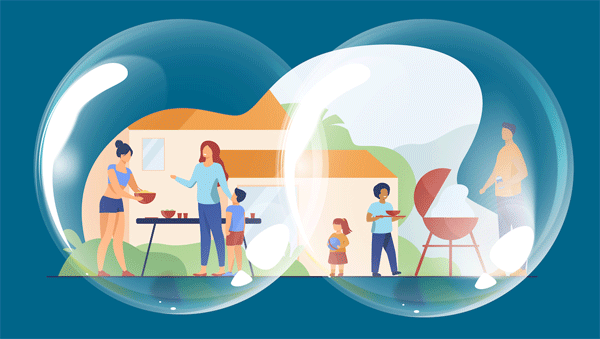The Problem with Social Bubbling
Dec. 29th, 2020 01:32 pmNot long after Coronavirus became a global pandemic and everyone was told to practice social distancing a compromise was suggested that would allow some in-person contact with others: Bubbling. The idea was you could form a social bubble including, say, your family and another family.

If you have kids you know they want to play with their friends. To stop them you'd have to keep them in the house most of the time and establish fairly draconian rules for when they're outside. Plus, it's not just kids. We adults need human contact, too. Pretty much all of us have people we'd appreciate visiting— a neighbor, a few close friends, relatives who live nearby, etc. So, the idea went, why fight human nature when you could work with it but just put some commonsense rules around it. The idea was, as long as you know who you're bubbling with and keep the bubble tight, you're not significantly increasing your risk of exposure to COVID-19.
The problem with bubbling is that keeping the bubble tight is way easier said than done. I thought about this when I first saw the concept months ago. Suppose you decide to bubble with your next door neighbor. The kids can play and the adults can enjoy picnics together. But who else is in each family's bubble? If the kids go to school or daycare, they're in a bubble with all those other kids... and their families... and whoever else those families bubble with. And the adults in your bubble? What if one's an essential worker with lots of close contact in their job? What if you have a brother who lives nearby with his family and you go to visit them every few weeks? What if your brother or his spouse is lax about masks and social distancing?

In short the problem with making a bubble is that it's pretty much never going to be a small bubble. You may think it's small, and as a simple concept it certainly starts small, but by the time you finish connecting overlapping circles of who interacts with whom, it's huge. And worse, it includes a lot of people you don't know and/or can't trust to behave responsibly in your bubble.

If you have kids you know they want to play with their friends. To stop them you'd have to keep them in the house most of the time and establish fairly draconian rules for when they're outside. Plus, it's not just kids. We adults need human contact, too. Pretty much all of us have people we'd appreciate visiting— a neighbor, a few close friends, relatives who live nearby, etc. So, the idea went, why fight human nature when you could work with it but just put some commonsense rules around it. The idea was, as long as you know who you're bubbling with and keep the bubble tight, you're not significantly increasing your risk of exposure to COVID-19.
The problem with bubbling is that keeping the bubble tight is way easier said than done. I thought about this when I first saw the concept months ago. Suppose you decide to bubble with your next door neighbor. The kids can play and the adults can enjoy picnics together. But who else is in each family's bubble? If the kids go to school or daycare, they're in a bubble with all those other kids... and their families... and whoever else those families bubble with. And the adults in your bubble? What if one's an essential worker with lots of close contact in their job? What if you have a brother who lives nearby with his family and you go to visit them every few weeks? What if your brother or his spouse is lax about masks and social distancing?

In short the problem with making a bubble is that it's pretty much never going to be a small bubble. You may think it's small, and as a simple concept it certainly starts small, but by the time you finish connecting overlapping circles of who interacts with whom, it's huge. And worse, it includes a lot of people you don't know and/or can't trust to behave responsibly in your bubble.
no subject
Date: 2020-12-30 11:49 pm (UTC)Moreover, if your model rests on the assumption that one person is sick with Covid to prove its payoff matrix is a big win, really that proves the model is flawed. If it can be assumed that one person in the group is sick then you should identify that person and exclude them. Otherwise you're just rearranging deck chairs on the Iitanic.